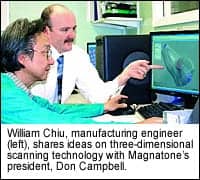The president of the 40-year-old, family-owned-and-operated Magnatone wants audiologists to know that his company offers a comprehensive line of hearing health care products.
Don E.K. Campbell feels frustration every time he wanders into a conversation in which audiologists are discussing his company, Casselberry, Fla-based Magnatone Hearing Aid Corp, and one of them chimes in with words to the effect of “Magnatone, oh, sure, I’m acquainted with the name—aren’t they the people who do rechargeable hearing aids?”

It is a mystery to Campbell why so many hearing-health professionals have it stuck in their minds that Magnatone is narrowly focused when nothing could be further from reality. But, by year’s end, that perception could be forever shattered: the company plans to unveil a hearing instrument utilizing a technologic breakthrough that carries the potential to shake up the broad marketplace.
Details surrounding this innovation are closely guarded, and Campbell will not offer so much as a hint for fear of putting at risk the company’s patent filing, which has yet to be completed. He does, however, share that the technology is not related to the shell but to the actual workings of the instrument. Says Campbell, “We believe this new technology will be as significant as digital was when it first arrived. It’s impressive technology that will virtually eliminate the need for follow-up adjustments. We think our customers will be very satisfied by it.”
RECIPE FOR SUCCESS
Employing 100 individuals and operating from a 16,000-square-foot design-production-distribution complex, Magnatone has been impressing consumers since 1967 with custom-crafted hearing instruments matched to the wearer’s unique specifications.
“We are a company that has always strived to do and offer more, for less,” says Campbell. “Our aim is keeping the value proposition high—and that means great products at low prices.”
Magnatone products are sold the world over, but it is only recently that the company has seriously begun pushing for international market share. For example, 2 years since entering Turkey, Magnatone is now one of that country’s largest suppliers. “We recognize the difficulty in changing the competitive complexion of the world markets we hope to enter, especially Europe, so our strategy is to work our way inward from the four corners of the globe,” Campbell explains. “And, in order to pave the way for European penetration, we’ve had to obtain certification under the ISO 9001-2000, ISO 13485-2003, and CE international standards for quality assurance and safety.”

The Monet line recently expanded to include The Shadow, an on-the-ear instrument characterized by unibody construction. “This is an industry first, an instrument built without traditional seams or screws to secure the pieces of the housing,” says Campbell.

Intentions are to roll out The Shadow in a variety of design and color options. “We’re very enthusiastic about the prospects for this product, in no small part because of the phenomenal acceptance for open-ear instruments among first-time wearers,” says Campbell. “In the past, those first-timers have been discouraged from going with open-ear instruments because the cost was too high. We’re positioning The Shadow as an affordable solution.”

A key to Magnatone’s success is its use of laser 3D shell-making equipment. Basically, an impression of the wearer’s ear is taken by means of a laser-produced digital scan that then is transferred into a three-dimensional computer model. The exact shape of the ear is captured as millions of data points. Next, the digitized model is translated by software into output instructions for a fabrication machine.
“The technologic edge we get from this approach allows us to consistently and efficiently produce well-fitting hearing instruments—a perfect fit being essential to the satisfaction of the wearer,” says Campbell. “What we have noticed is that, because of our reliance on technology in this manner, our recase rates are virtually the lowest in the industry. For example, in April, we averaged a 3.2% recase rate on canal aids, and that includes requests for longer or shorter canals, and things that we have no control over, such as poor impressions. The most interesting effect of all this was a lowered return-for-credit rate. In April, that rate for canal aids was 4.7%—nearly 60% below industry averages.
“However, even though we use technology that delivers the highest level of accuracy available today, it still takes us twice as long as most other 3D-equipped companies to build a platform of shells—6 hours compared to their 3. But that’s only because the others run a less accurate platform, which they then follow with buffing of the shell to obtain a final resolution. We think that’s the wrong way to go. If you’re going to spend $500,000 on this type of technology, it makes no sense to then revert to a manual process that’s prone to error just to be able to say you’ve halved your time in production.”
CHANGED HANDS
The manual process of shell buffing was the first job Campbell held with Magnatone some 30 years ago, when he was a child. “It’s how I spent my vacations when school let out for the summer,” he muses.
Before Magnatone was owned by the Campbell family, it was the possession of its founder, a Miami civil engineer. “His father needed a hearing aid, and he had an idea of how to develop one that would be just perfect for him,” Campbell tells. “At the time, there were no truly custom hearing aids—semicustom was the best you could get.” The founder’s first stab at a custom product originated in his garage workshop. “It turned out so well that he thought he could take his concept to the marketplace and have a really successful business,” says Campbell.
In short order, the garage-based venture turned into a formal company and took on the name Magnatone. Its manufacturing facility included a retail showroom from which custom hearing aids were sold direct to consumers.
By 1971, Magnatone had grown to three employees, but was experiencing only marginal success. That year, the founder decided to put Magnatone up on the block. Campbell’s mother Beverly, a secretary in the chief executive’s office, offered to buy it. “Even though Magnatone seemed to be gaining little traction at the time, she recognized the potential of the company and believed it had a future and could be successful,” says Campbell. “The only problem was, she didn’t have enough money to make the purchase.” Happily, the owner helped Beverly Campbell obtain sufficient financing to complete the transaction.
Under new management, Magnatone chugged along for the next decade, its fortunes cyclically flowing and ebbing until the early 1990s when the company hit its stride. From then on, Magnatone largely stayed in the black, and has benefitted from the decision made early by the Campbell family to plow all profits back into the operation to pay for new and better technology—thus enabling the business to grow faster and stronger. (Beverly Campbell, who holds the posts of CEO and board chairman, is semiretired.)
THE WEAKEST LINK
Today, Campbell believes his company is well positioned by dint of its longevity and reputation for quality products and technical support to capture market share as the Baby Boom generation grays and loses hearing ability. “Just in general because of the Boomers being so significant a population, it’s an ideal time to be in the hearing aid business,” he says.
Still, there is that matter of industry misconceptions about Magnatone. Campbell thinks some of that is the result of the company not getting its message out to the colleges where audiologists are trained and receive their first exposure to the universe of hearing aid products. “The students don’t learn about our products and so they come out of the schools not knowing who we are,” he says. “I’ll admit it—marketing has to be considered our weakest link. Marketing is something we must work on.”

Campbell reveals that Magnatone intends to increase its participation with www.audiology.com, the Internet site for those seeking independent information about hearing loss and hearing instruments. “We believe that comment about and, hopefully, endorsements of our products by fellow professionals speaking as unaffiliated observers and critics will only enhance our credibility,” says Campbell.
Magnatone during the past several years has eschewed display advertising in audiology and related hearing-health journals, but is contemplating reinstatement of the practice of using those types of publications in its outreach efforts. The company produces—and plans to continue producing—a quarterly newsletter to keep customers and providers aware of inside developments. “Few companies provide any kind of newsletter anymore,” Campbell laments. “We put a lot of effort into the production of ours because we feel it is such a valuable and effective form of communication. We even allow our customers to post classified ads at no cost in the back of the publication.”
BY ANY OTHER NAME
It has been suggested to Campbell by well-meaning observers that Magnatone might be able to further burnish its image and raise its visibility were it to adopt a more contemporary, cutting-edge-sounding name. This flies like a lead balloon as far as Campbell is concerned. “Magnatone, they tell us, is a name that evokes imagery of the analog past, from an era when the suffix ‘tone’ was used in the names of a lot of companies no longer around,” he says. “Change the name to something catchy for the times, we’re advised, and watch how fast hearing professionals and consumers begin associating the company with innovation, we’re promised.
“Well, the fact of the matter is, we like our name. It’s a name that has been around a long time and it’s the name people know us by. It may not be a fancy name by today’s standards. It may not be suggestive of innovation. But Magnatone is not—nor has it ever been—a company that has had to play those kinds of games. Magnatone is a company that has withstood the test of time and succeeded by bringing good products to market, making sure they fit the first time, are offered at attractive prices, and are supported with good service. That is the formula we’ve followed for the last 40 years; it is the formula we intend to follow for the next 40 years. We intend to follow it because it’s a formula that works.”
Rich Smith is a contributing writer for Hearing Products Report.





